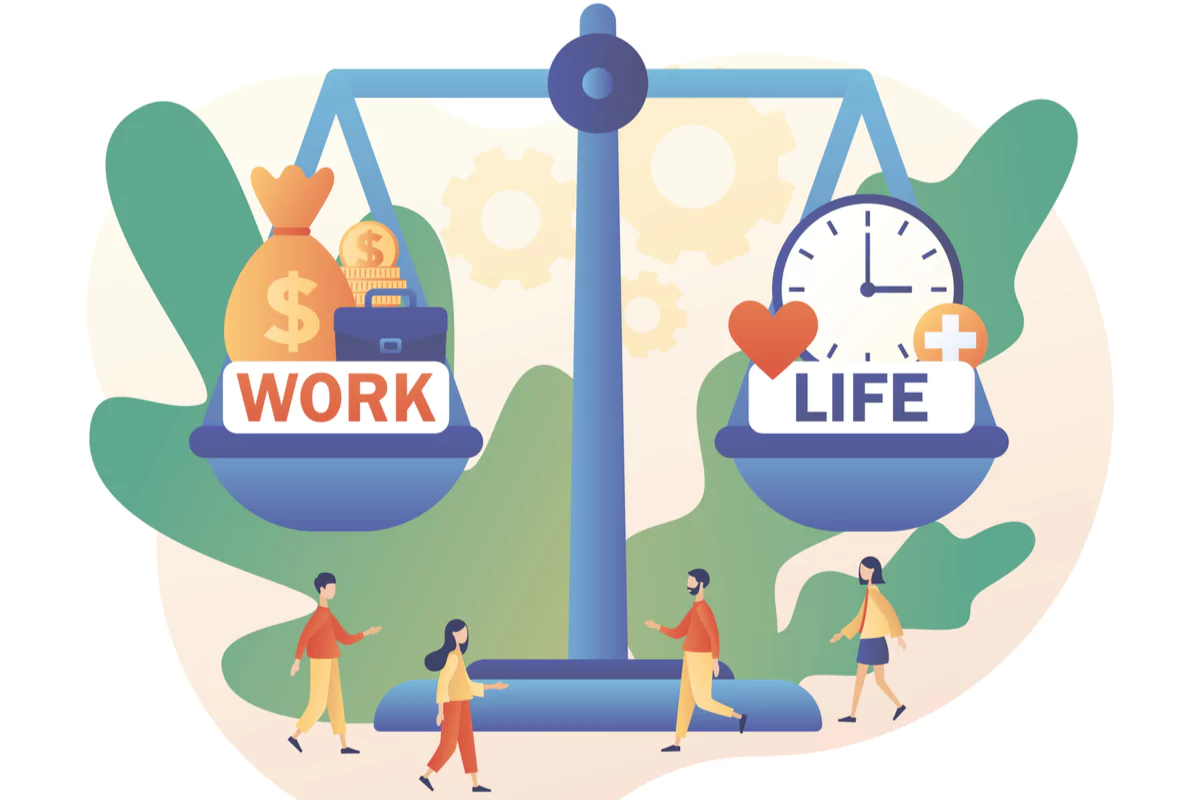Table of Contents
The Importance Of Work-Life Balance
How Can Employers Best Encourage Employee Work-Life Balance?
How To Improve Work Life Balance | Tips To Support Your Employees Better
The public dialogue over “work-life balance” has become increasingly popular among both employees and employers in the past several years, though definitions of the term vary wildly. Cambridge Dictionary’s definition — “the amount of time you spend doing your job compared with the amount of time you spend with your family and doing things you enjoy” is too simplistic. It implies that work-life balance can be achieved by splitting one’s time 50-50 between the office and home.
In contrast, Business News Daily’s definition — “the state of equilibrium where a person equally prioritizes the demands of one’s career and the demands of one’s personal life” — gives the impression that work-life balance is a highly complex matter that requires a huge amount of effort and ingenuity to achieve.
While definitions vary widely, there is hardly any disagreement over the importance of work-life balance for employees and their employees. Nearly across the board, research shows that employees who achieve work-life balance are more productive, happier, healthier, and more likely to remain at their jobs. Companies and small business owners would be wise to take an active role in helping their employees attain a work-life balance.
Below are the implications of work-life balance for your company and what you can do to make work-life balance part of your company’s culture.

The Importance Of Work-Life Balance
Employees who lack a work-life balance suffer from greater levels of stress and stress-related illness. They experience higher rates of family conflict and divorce. A poor work-life balance carries over to the workplace with some negative consequences. Conversely, work-life balance increases employee engagement and productivity.
Productivity
A growing body of evidence shows that there is a positive correlation between work-life balance and employee productivity.
- A sweeping study by the Corporate Executive Board (which represents 80% of Fortune 500 companies) found that employees who believe they have good work-life balance work 21% harder than those who don’t.
- A study conducted by the British Government on how work-life balance affects employee performance found that an employee’s wellness results in better performance and quality of work.
- In its Future of Benefits Pulse Survey, The Hartford found more than 60% of respondents feel that their health and wellness affect their work productivity.
- Among companies offering wellness programs, 66% saw increased productivity from their employees.
Employee Burnout
- In 2019, the World Health Organization (WHO) recognized burnout as an occupational phenomenon that results from chronic stress in the workplace. It causes employees to feel depleted of energy, mentally detached, and cynical about their job. Employees without work-life balance are highly susceptible to burnout.
- A Deloitte survey of 1,000 full-time US professionals 77% of respondents say they have experienced employee burnout at their current job, with more than half citing more than one occurrence.
- A Gallup study of nearly 7,500 full-time employees found that two-thirds of full-time workers experience burnout on the job, with 23% of respondents feeling burned out at work always or often or always and an additional 44% feeling burned out occasionally.
- Another survey showed that companies with employees who have good work-life balances report a 50% reduction in healthcare costs.
Employee burnout can be quite expensive for businesses. Employees who are burned out take more sick days and develop more health issues. Your company’s productivity will suffer as your health care costs rise. The greatest cost of employee burnout is the money it takes to hire and train a replacement.
Retention And Recruitment
There is a direct correlation between work-life balance and employee turnover as well as employee recruitment.
- 53% of employees report that having a job that provides them with greater work-life balance is “very important”.
- A Kronos and Future Workplace study cited burnout as a significant threat to employee retention, according to 95% of human resource leaders surveyed.
- According to The Society for Human Resource Management, it costs a company, on average, six to nine months of an employee’s salary to find and train a replacement.
- Work-life balance is one of the most sought-after aspects of a job among job seekers with 72% of employees considering work-life balance to be of great importance when looking for a new job.
- A widely cited Randstad Employer Brand Research report found that 45% of surveyed employees said that work-life balance is a key attribute of a job’s appeal.

How Can Employers Best Encourage Employee Work-Life Balance?
Companies can help their employees reach a work-life balance by implementing several
work-life balance employee benefits. Here are the most common and effective ways to encourage work-life balance among your employees.
Ask Employees What They Need
Before you make any major changes to your company’s policies, ask your employees for their thoughts on the matter. Send out an employee survey on work-life balance and what they need from you to attain such balance in their lives.
Include questions about work hours and habits, family obligations, and time for leisure. Some sample work-life balance employee survey questions are:
- How satisfied are you with your current work hours?
- How often do you take work home?
- Do you check emails after you leave the office?
- Does your schedule allow you to spend quality time with friends and family?
- Have you missed a personal event because of work?
- Do you have time to pursue personal interests and hobbies?
- Does your manager respect your work-life balance?
- How many hours do you sleep on an average work night?
- Is the company’s overall culture empathetic to your needs?
By asking probing questions in advance, you can avoid wasting time creating ineffective policies.
Implement Flexible Work Schedules
Workdays need not be one-size-fits-all. Some employees may be more productive earlier in the day while others are at their best in the afternoons. Others may have family obligations to attend to on weekdays. A flexible work schedule (or “flextime”) allows employees to choose their hours rather than adhering to the traditional Monday to Friday, 9 to 5 workday.
Flextime can still require that workers put in the same number of hours each week and complete tasks by a given deadline. But giving employees the choice of when to perform this work can yield positive results for your company. Flextime can lead to significantly higher productivity and employee engagement.
Employees are showing a greater desire for flextime. A 2020 survey of 3,500 employees revealed that 81% of respondents placed a high value on flexible working schedules. Not only do employees want flexible work options, but they also report that such options impact their well-being.
A 2020 survey conducted by Mental Health America and FlexJobs asked 800 employed individuals about how flexible work options impact their wellness. Of those who have flexible work options, 48% reported that they have a very good or excellent work-life balance. This survey also found that:
- 56% of respondents stated that their employer could better support them by providing workday flexibility
- 80% said that flextime would improve their quality of life overall and 83% stated that flextime would lower their stress levels.
- 92% believed that having a flexible job makes (or could make) them happier.
Statistics like this prove that if at all practicable, you should implement flextime and allow for varying start and end times to the workday.
Allow Employees to Work Remotely
Research continues to show that workers want the opportunity to work from home on a full or part-time basis. A McKinsey & Company research survey in 2020 found that 80% of respondents said they enjoyed working from home. Owl Lab’s 2019 State of Remote Work report surveyed 1,200 employees and found that 71% of remote employees said they are happy in their job, whereas only 55% of on-site employees said the same.
In that same Owl Lab survey, respondents’ reasons for opting to work remotely included achieving a better work-life balance (91%), increasing their productivity (79%), and lowering stress (78%).
If fully remote employment is not possible, a hybrid work model that allows employees to work from home for a few days can still provide some relief from stress and burnout. Check out our guide for improving the quality of virtual meetings!
Offer Job Sharing Opportunities
Job sharing is an arrangement in which one full-time position is filled by two or more people working on a part-time basis. This employment model offers the kind of flexibility that parents and caregivers need and that working students or employees nearing retirement want.
Allowing employees to have the time for their personal obligations helps them achieve a work-life balance. Employers benefit from job sharers’ increased productivity as well as loyalty which translates into lower turnover.

Provide Paid Time Off (PTO)
Most companies’ benefits packages include vacation time, sick days, and personal days. Bringing all these days under one banner, called Paid Time Off (PTO), shows your employees that you trust them to determine when and why to take time off from work.
Paid time off can reduce chronic stress and lessen the possibility of employee burnout. Time away from work enables work-life balance by giving employees more time to be with their significant others, families, and friends.
Employers also benefit when their workers take time off. An American Psychological Association survey found that a majority of employees reported that upon their return from time off that they had greater energy (66%), were more motivated (57%), and were more productive (58%).
Encourage Time Off
Though you may offer paid time off, employees don’t always take advantage of that time. Every year millions of paid time off days go unused. In 2018, American workers left 768 million days of vacation time unused. To help your employees find a work-life balance, you need to actively encourage employees to take time off.
According to a 2017 survey by Glassdoor, there is a multitude of reasons why employees do not use their paid time off for vacations or staycations. Some of these reasons are that they are:
- Concerned that they will seem undedicated or even replaceable
- Not sure that their employer actually wants them to take time off
- Have too great a workload and are afraid of falling behind
- Feel guilty that they are leaving the team with more work
- Expected to check email and voicemail while on vacation
You can assuage some of these concerns by creating a company culture that encourages time off. Let your employees know that you value them and their well-being. Assure them that you will not contact them during their time off and that they are not expected to perform any tasks related to work while away from the office.
Review workloads frequently to ensure that your employees are not overloaded. Insurmountable workloads leave employees fear that if they take time off they will fall behind and perhaps even lose their job as a result.
Only allow limited carryover of unused paid time off. If employees know that any PTO they don’t use now will carry over to the following year, they may continually postpone taking that time. Workaholics have increased stress, health problems, lower productivity, and will eventually succumb to burnout. Your company will suffer as a consequence, so be insistent that your employees take time off for their own good.
Establish Work Hour Boundaries
The Organization for Economic Co-operation and Development (OECD) found that 11.4% of American employees work more than 50 hours a week and 33% state they work on weekends and holidays. Yet overworked employees are in fact much less productive than those who balance their work and personal lives. Employee productivity drops 19% for every hour worked beyond the standard 8-hour day. Accordingly, limit your company’s workdays to eight hours.
This means more than locking up the office. In an always-on, 24/7 world, employees may not leave work at the office. Delineate ‘responsive’ hours so employees know that they are not expected to reply to work emails or calls received after hours. The “always-on” expectation of businesses has become so pervasive that several European countries have passed “right to disconnect” laws to protect workers from the pressure of being available around the clock.
Institute No-Meeting Hours or No-Meeting Days
Employees are spending more time in meetings, especially virtual ones, than ever before. Zoom fatigue is both real and rampant. Limiting meetings to specific times of the day, or banning them entirely from certain workdays, helps employees be less stressed and more productive. A 2022 survey conducted by MIT Sloan Management Review revealed just how profound the impact of fewer meetings was on productivity.
Companies that banned meetings one day a week saw a 35% increase in productivity. When meetings were banned two days a week, productivity jumped a massive 71%. Meeting free days also increased engagement and lowered stress. This isn’t to say that meetings aren’t necessary. But they aren’t always needed. When they are, follow effective meeting practices to maximize the time you have.
Implement Employee Wellness Programs
Wellness programs for employees can include things like gym memberships, reimbursement for weight management programs, and subscriptions to mental fitness apps like Calm and Headspace. Regular exercise is a major stress-reducer. But employees may not find time for it given personal and professional demands. Instead of paying for gym memberships that might go unused, pencil in time for physical activity in your office. Offer light workout classes or yoga sessions during work hours. Bring in a live instructor or utilize online classes.
Lead By Example
If you want your employees to buy into policies and practices that encourage a work-life balance, leadership must model the behavior they seek from their employees. Managers should not call into the office during vacations so that employees see that they too can turn off their laptops and cellphones during their time off. Leaders should take advantage of company benefits like a wellness program, not only to model behavior but to benefit themselves.
Taking brief breaks throughout the day or stepping outside for fresh air to rejuvenate will encourage your employees to do the same. Schedule time away from the office as a team. Spend fun time together playing team building games and activities. This demonstrates your belief that time away from work – be it a vacation or a coffee break – is essential to both your employees’ work-life balance.

How To Improve Work Life Balance | Tips To Support Your Employees Better
Beyond initiating formal policies like those above, you can also do the below activities and methods to enable your employees to find a work-life balance.
Invite Family And Friends To Company Gatherings
When appropriate, include employees’ family and friends in planned events. Allowing employees to bring their loved ones to holiday parties and companywide celebrations means they won’t miss out on important family time.
Individual employee milestones like birthdays, work anniversaries, and especially retirement parties should include family. Other events that are ideal for employees’ families and even pets to attend are company picnics or other company outings like sports events or concerts.
Use Team Building Activities
Although team building activities take place during work hours and are part of the job, they can improve your employees’ wellness. Team building helps develop positive interactions between coworkers, boosts company morale, and creates a sense of camaraderie. Team building games bring laughter and fun into the office which can reduce some of the stress that employees feel at work.
Many team building games take place outside of the office and are more about having good times than developing healthy work skills. Some fantastic off-site team games are escape rooms, scavenger hunts, and paint balling. Your remote employees can also partake in the fun as there are dozens and dozens of enjoyable virtual team building activities and games. You can even kick off the team building activities with some fun ice breakers!
Create A Culture of Recognition
Recognizing the contributions of team members lowers feelings of stress while increasing feelings of belonging. Recognition also improves employee engagement and work-life balance. Holding employee award ceremonies and celebrating employees’ work milestones like anniversaries shows that your company appreciates its most important asset – its employees. Here are 22 employee appreciation ideas for onsite workers and 21 virtual employee appreciation ideas.
Encourage Breaks Throughout The Day
Studies show that taking breaks during work can alleviate some stress during the workday which helps employees’ overall wellness. Breaks also increase productivity and creativity, foster well-being, and restore focus. Encouraging breaks shows that your company values your employees’ well-being. If your team is remote, schedule daily virtual coffee breaks and virtual water cooler gatherings.
Offer Growth Opportunities
Acknowledging your employees’ growth potential makes them feel valued. Provide opportunities for additional training. Create mentorship programs. Invite current employees to serve as an “onboarding buddy” as part of a new employee’s onboarding process. Onboarding buddies serve as an informal resource for new hires. Among the tasks of an onboarding buddy are to make introductions and facilitate networking. They help your new hire navigate the company structure, make introductions, and facilitate networking. Serving as an onboarding buddy offers your employees an opportunity to develop leadership skills.
Give Time Off For Volunteering
Give your employees time off to perform volunteer work. This time off should be an addition to their paid time off. People who volunteer are more satisfied with their work-life balance than those who don’t volunteer, according to a study by the Journal of Occupational and Environmental Medicine. Additionally, volunteering reduces stress and the likelihood of burnout. Consider arranging a time for your teams to perform volunteer work together. Look at VolunteerMatch to locate nearby volunteer projects.
Final Thoughts
Improving employee work-life balance should be a goal your company embraces, not only for the health and happiness of your employees but for your organization’s well-being. Employees with work-life balance are an asset to your company. They are more productive, engaged, and happier. They take fewer sick days off and are more immune to burnout. Implementing work-life balance benefits makes your organization more attractive to top talent and more likely to retain your best employees.

